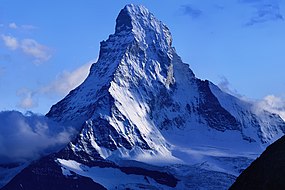
Back Matterhorn Afrikaans Matterhorn ALS Cervino AN ماترهورن Arabic ماتيرهورن ARZ Matterhorn Azerbaijani Матэргорн Byelorussian Матэргорн BE-X-OLD Матерхорн Bulgarian ম্যাটারহর্ন Bengali/Bangla
| Matterhorn | |
|---|---|
 East and north faces of the Matterhorn | |
| Highest point | |
| Elevation | 4,478 m (14,692 ft) |
| Prominence | 1,043 m (3,422 ft) ↓ Col Durand[note 1] |
| Parent peak | Weisshorn |
| Isolation | 13.8 km (8.6 mi) → Liskamm-West Top[note 2] |
| Listing | Alpine four-thousanders Great north faces of the Alps |
| Coordinates | 45°58′35″N 7°39′31″E / 45.97639°N 7.65861°E[1] |
| Naming | |
| Native name | |
| English translation | (German) "Peak of the Meadows"[2] (Arpitan) "Great Mountain" |
| Geography | |
| Location | |
| Parent range | Pennine Alps |
| Topo map | swisstopo 1347 Matterhorn |
| Climbing | |
| First ascent |
|
| Easiest route | Hörnli ridge (AD, rock/mixed climb) |
The Matterhorn (German: [ˈmatɐˌhɔʁn] ⓘ, Swiss Standard German: [ˈmatərˌhɔrn]; Italian: Cervino [tʃerˈviːno]; French: Cervin [sɛʁvɛ̃]; Romansh: Mont(e) Cervin(u)[note 3] or Matterhorn [mɐˈtɛrorn]) is a mountain of the Alps, straddling the main watershed and border between Italy and Switzerland. It is a large, near-symmetric pyramidal peak in the extended Monte Rosa area of the Pennine Alps, whose summit is 4,478 metres (14,692 ft) above sea level, making it one of the highest summits in the Alps and Europe.[note 4] The four steep faces, rising above the surrounding glaciers, face the four compass points and are split by the Hörnli, Furggen, Leone/Lion, and Zmutt ridges. The mountain overlooks the Swiss town of Zermatt, in the canton of Valais, to the northeast; and the Italian town of Breuil-Cervinia in the Aosta Valley to the south. Just east of the Matterhorn is Theodul Pass, the main passage between the two valleys on its north and south sides, which has been a trade route since the Roman Era.
The Matterhorn was studied by Horace-Bénédict de Saussure in the late eighteenth century, and was followed by other renowned naturalists and artists, such as John Ruskin, in the 19th century. It remained unclimbed after most of the other great Alpine peaks had been attained and became the subject of an international competition for the summit. The first ascent of the Matterhorn was in 1865 from Zermatt by a party led by Edward Whymper, but during the descent, a sudden fall claimed the lives of four of the seven climbers. This disaster, later portrayed in several films, marked the end of the golden age of alpinism.[3] The north face was not climbed until 1931 and is among the three biggest north faces of the Alps, known as "The Trilogy". The west face, the highest of the Matterhorn's four faces, was completely climbed only in 1962. It is estimated that over 500 alpinists have died on the Matterhorn, making it one of the deadliest peaks in the world.[4]
The Matterhorn is mainly composed of gneisses (originally fragments of the African Plate before the Alpine orogeny) from the Dent Blanche nappe, lying over ophiolites and sedimentary rocks of the Penninic nappes. The mountain's current shape is the result of cirque erosion due to multiple glaciers diverging from the peak, such as the Matterhorn Glacier at the base of the north face. Sometimes referred to as the Mountain of Mountains (German: Berg der Berge),[5] it has become an indelible emblem of the Alps in general. Since the end of the 19th century, when railways were built in the area, the mountain has attracted increasing numbers of visitors and climbers. Each year, numerous mountaineers try to climb the Matterhorn from the Hörnli Hut via the northeast Hörnli ridge, the most popular route to the summit. Many trekkers also undertake the 10-day-long circuit around the mountain. The Matterhorn has been part of the Swiss Federal Inventory of Natural Monuments since 1983.
Cite error: There are <ref group=note> tags on this page, but the references will not show without a {{reflist|group=note}} template (see the help page).
- ^ "Commune Zermatt" (Map). Matterhorn peak (digital ed.). 1:10 0000. National Map 1:10'000. Wabern, Switzerland: Federal Office of Topography – swisstopo. Retrieved 2018-01-23 – via map.geo.admin.ch.
- ^ Cite error: The named reference
Lunn1965was invoked but never defined (see the help page). - ^ Messner, Reinhold (September 2001). The big walls: from the North Face of the Eiger to the South Face of Dhaulagiri. The Mountaineers Books. p. 46. ISBN 978-0-89886-844-9. Retrieved 13 July 2011.
- ^ "Grave of the Unknown Climber". zermatt.ch. Zermatt Tourism. Archived from the original on 19 May 2021. Retrieved 4 April 2021.
The "Grave of the Unknown Climber" is located in the Mountaineers' Cemetery. It reminds us of the more than 500 deaths, which have taken place on the Matterhorn since 1865. And of the missing and dead, who could not be found or completely removed after their fall.
- ^ Gieri Venzin, ed. (2 April 2015). "Literatur zum Berg der Berge" (in German). Zurich, Switzerland: SRF. Archived from the original on 2016-04-06. Retrieved 2016-09-21.

